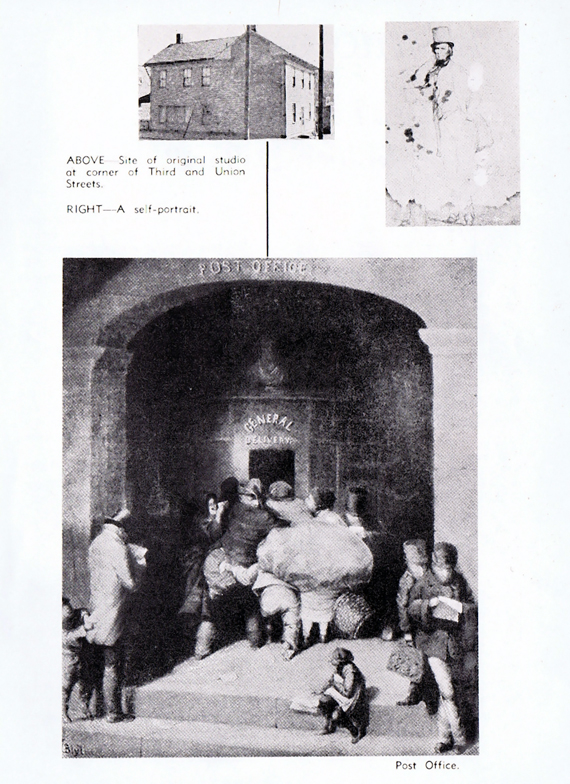| Originally appeared in Memories and Skills, the Fourth Annual Tri-state Pottery Festival Booklet, June 17-18-19. 1971. |
The rough and tumble life in early East Liverpool helped to -produce some of the most colorful and witty characters around, and in the case of David G. Blythe also one of the most talented.
The man himself was a colorful character with a tall lanky physique, enlivened by a red beard, fierce black eyes, and a fiery temperament. His wit and charm captivated tavern cronies and socialites alike.
Born in 1815 on a small farm outside of East Liverpool the youth spent his time drawing crude sketches with a bit of burnt wood and a shed door for a medium. This foiled to satisfy his restless spirit and clever hands and so he sought apprenticeship with Joseph Woodwell, at that time Pittsburgh's foremost woodcarver.
After an interlude of approximately seven years Blythe returned to East Liverpool. Here he eked out a livelihood as an itinerant portrait painter. Many of the paintings done during this period now hang in the museum at the Carnegie Library.
In the course of his wanderings in search of commissions Blythe reached Uniontown, Pa. and in 1846 decided to settle there. At about the some time he married Julia Keffer, also from East Liverpool. About a- year later she was to die of typhoid fever. This and the failure ofhis 300-foot panorama to make a profit were to bring changes into Blythe's life and his style of painting.
Blythe took to serious drinking. Settling in Pittsburgh, he revolted against flattering portraiture and turned to caricature. He painted grinning bill collectors, drunks, loafers, pickpockets, runaway horses, and swaying -stagecoaches. In short, very little that was Pittsburgh escaped his sight. This was Blythe at his best.
Years of restless wandering and a close companionship with "old demon rum" brought to an end Blythe's relatively short but colorful life. He died May 15, 1865, penniless. A modest monument marks his burial place in Spring Grove Cemetery.
David Blythe was a Pittsburgh legend for years after his death, but hardly anyone outside western Pennsylvania and eastern Ohio had heard of him, until Pittsburgh's Carnegie Institute gave his paintings a showing in 1932.
David Blythe was a Pittsburgh legend for years after his death, but hardly anyone outside western Pennsylvania and eastern Ohio had heard of him, until Pittsburgh's Carnegie Institute gave his paintings a showing in 1932.
Today paintings by David Blythe are treasured for the sympathy or laughter their subjects evoke. It was a racy art, of the people, passing no moral judgments, delighting in the squalor, knavery and mischief of a frontier community, pleased equally with the spectacle of a boy picking pockets and of a lawyer hypnotizing the morons of a jury.

This site is the property of the East Liverpool Historical Society.
Regular linking, i.e. providing the URL of the East Liverpool Historical Society web site for viewers to click on and be taken to the East Liverpool Historical Society entry portal or to any specific article on the website is legally permitted.
Hyperlinking, or as it is also called framing, without permission is not permitted.
Legally speaking framing is still in a murky area of the law
though there have been court cases in which framing has been seen as violation of copyright law. Many cases that were taken to court ended up settling out-of-court with the one doing the framing agreeing to cease framing and to just use a regular link to the other site.
The East Liverpool Historical Society pays fees to keep their site online. A person framing the Society site is effectively presenting the entire East Liverpool Historical Society web site as his own site and doing it at no cost to himself, i.e. stealing the site.
The East Liverpool Historical Society reserves the right to charge such an individual a fee for the use of the Society’s material.